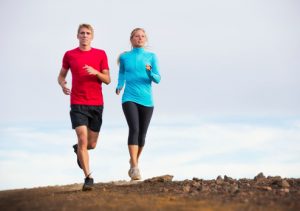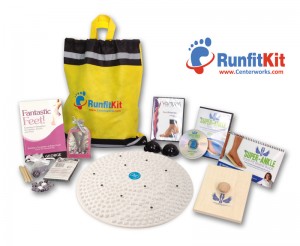8 Ways Pilates Benefits Runners – Why Pilates is Important to Reduce the Risk of Running Injuries
 Are you passionate about running? It doesn’t matter if you’re super-speedy or slow, if you love to run just to run or if you’re a little more competitive and plan your life around your favorite races. If running is your #1 workout of choice, it’s going to be the one thing that’s going to happen regardless of how crazy your life gets. But how many running buddies do you know who are plagued with aches, pains, and injuries? Maybe it’s an Achilles tendinitis issue, plantar fasciitis problem, knee pain, a pulled hamstring, hip pain, or SI Joint and low back pain problems. I often hear runners say, “It only hurts a little bit. Once I start running I don’t notice it so I’m not going to stop running…” The problem is they are actually ignoring the signals the body is sending them and are making things worse instead of better! Luckily, I’m here to tell you that Pilates benefits runners!
Are you passionate about running? It doesn’t matter if you’re super-speedy or slow, if you love to run just to run or if you’re a little more competitive and plan your life around your favorite races. If running is your #1 workout of choice, it’s going to be the one thing that’s going to happen regardless of how crazy your life gets. But how many running buddies do you know who are plagued with aches, pains, and injuries? Maybe it’s an Achilles tendinitis issue, plantar fasciitis problem, knee pain, a pulled hamstring, hip pain, or SI Joint and low back pain problems. I often hear runners say, “It only hurts a little bit. Once I start running I don’t notice it so I’m not going to stop running…” The problem is they are actually ignoring the signals the body is sending them and are making things worse instead of better! Luckily, I’m here to tell you that Pilates benefits runners!
It’s hard to stop doing something you love. Especially when it’s something that helps de-stress your body, gets the blood pumping, fills you with endorphins, and makes you happy. But wouldn’t it be even better if you could run without pain or fear that you’re going to aggravate an old injury? Would the extra time cross training with Pilates be worth it if it could help you improve your core support, free up your hips, improve the mobility of your hamstrings, help your knees, and fix your feet? Pilates benefits runners because it has so many excellent whole-body health benefits. If you love to run, Pilates can help keep you in tip-top shape to make the most of your miles whether you’re pounding the pavement, hitting the trails, or sprinting on the track.
Personally, it’s difficult for me to call myself a “runner” since slow-mo is my M.O. But I do enjoy getting out there and I have even done a couple of half-marathons. For me it’s not about being competitive, but the act of moving, enjoying the fresh air and sunshine, and getting some cardio accomplished with a little extra impact to help keep my bones strong.
When I was younger (in my teens and twenties), way before I knew anything about Pilates, I basically ran from injury to injury! I’d get inspired to want to add more running to my weekly workouts and as I upped my mileage, or attempted to speed things up. Inevitably, I’d end up with something hurt. Never the same part of my body; sometimes it was a foot issue, Achilles tendinitis, sprained ankle, or plantar fasciitis problem. Sometimes my knees would hurt. Sometimes my back would go out. Other times I’d pull a hamstring. It was annoying, frustrating, and made my attempts at running as successful as yo-yo dieting! But this was BEFORE I started doing Pilates.
While I wasn’t looking at Pilates as an activity to cross-train and improve my running when I started, it’s had miraculous affects on my ability to maintain an active lifestyle with fewer aches and pains. Now I rarely, if ever, have an activity halting injury. I’m sure the Pilates clients I have that are runners will all agree that Pilates has made a big difference in their core support, body alignment, and ability to find and use the right muscles for a healthy stride.
As a runner, the one activity you want to focus all your time on is running. But if you’re willing to invest a couple of hours a week to do Pilates, you’re going to gain the benefits of a more balanced body and fewer aches and pains. Aches and pains that never seem like a big deal until you can’t run because you’re injured.
This is a general statement, but most of the runners I know hate to stretch. Tight, strong quads, hamstrings, and calves are contributing factors to an increased risk of injury. Then there’s the repetitive motion of running. Your dominant “running” muscles are getting stronger while the rest of your body is getting weaker. When the imbalance becomes too great, an injury will result. And you can’t forget about the feet…a very important part of a healthy stride. If you tend to pronate or supinate – even if you’re wearing shoes that are supposed to help correct this – the primary corrections need to be with how you’re using the muscles from the toes, thru the foot, to the ankle, calf, and all the way up to the hips! This can be very challenging to correct when you are full weight bearing with years of ingrained running habits. Plus, it’s difficult to make changes when you’re moving quickly during a running workout.
Unless you’re being coached at a very high level, or are a genetically gifted, mutant runner, you might not even realize the imbalances or poor body mechanics you’re using when you run, walk, and move through life. Finding, feeling, and fixing these functional movement patterns is what Pilates is all about.
Here are 8 ways Pilates Benefits Runners
- Pilates equipment is spring-tensioned providing both assistance and resistance to help improve functional movement habits. The springs on the Reformer, Cadillac and Chairs help you find and use new and better muscle habits that eventually will transfer back into running workouts to improve your stride. By working with the springs, you can learn how to better strengthen your abs and back and free up the legs to swing freely from the hips. You can also gain great insights for shoulder strength/mobility to better understand how to integrate healthy movement habits through your whole body. Pilates is an excellent way to connect both mind and body to re-train and re-educate your body for better health.
- Every Pilates exercise is a combination of both strength and flexibility. Just stretching isn’t ever going to help you get the strength and support you need in the opposing muscle groups for the too-tight muscles to let go.
- If you’ve been running and stretching for years and can’t figure out why you’re not getting more flexible – lack of balanced muscle development might be the reason why you’re seeing improvements.
- If you’ve been running and NOT stretching, doing Pilates exercises will take you through a full range of motion to improve mobility in a fun way that’s more effective than just “holding” a stretch.
- Pilates also helps build strength with length. Instead of focusing on the larger, bigger surface muscles, Pilates gets to the deeper, smaller, postural muscles and works the body from the inside out. Pilates can help you learn how to use your overdeveloped muscles a little less and your weaker muscles a little more. Balanced muscle development = a reduced risk of injury.
- Pilates can improve your breathing habits. Breathing is kind of important if you’re wanting to run or do other intensive cardio activities. The more efficient your breathing habits are, the easier it will be to pace your runs and maximize your oxygen availability. Better breathing habits can also help your back, arms, and shoulders move more easily for a healthy stride. If you’re back gets tight after a run or you end up with neck and shoulder pain, there’s a great chance that by learning Pilates posterior-lateral breathing skills you’ll free up your entire upper body, reduce back pain, and be able to breathe easier during your runs.
- Pilates can enhance body awareness. This is a concept that gets lost on a lot of people. Better body awareness is key to avoiding injuries. By becoming aware of your good and bad movement habits and doing Pilates exercises to help reinforce good body mechanics, you will gain the confidence needed to know when you’re moving in a healthy way or doing something that might get you hurt. Our muscles don’t have mouths. The only way the body can communicate with us is to send a pain signal. It’s important to learn to listen to the body. Pain is a signal that something is not quite right. A quick adjustment (if you knew what to do) might be all that’s needed. If making an adjustment or modification doesn’t eliminate a pain signal and we ignore it and continue, the risk of injury is imminent.
- Pilates improves both functional movement and stability. Every activity we do involves work and release. This requires our muscles to be proficient to support us for movement and stability. Learning how to gain control over work/release patterns and knowing the difference between when to use a muscle group for stability vs. movement can help avoid “tug-of-war” issues that can lead to injury. Stability in the right spots also means freer movement where it needs to happen. This helps improve both strength and flexibility and assists with balance and body control.
- Pilates is a barefoot activity. By exercising barefoot, you can become more aware of how you’re using your arches, ankles, and toes to help activate your feet and improve your alignment. Working against the springs on Pilates equipment helps stretch and strengthen your feet and ankles. There are lots of targeted foot and ankle exercises in Pilates that can help reduce the risk of ankle sprains, Achilles tendon issues, and plantar fasciitis problems.
*(All of my Pilates running clients also have a Centerworks® Runfit Kit at home, with extra foot fitness training tools and exercises for targeted foot care that can be used to warm-up and cool-down after a run or other fitness workout.)
- The things you can learn and improve with Pilates are limitless. Pilates is never boring if you’re working with a well-qualified Pilates Teacher who understands how to help you progress and fine-tune your form. An ideal Pilates workout is done on the Pilates Reformer, Mat, and supplemental exercises with the Cadillac/Trapeze Table, Chairs, and Barrels as needed. There are over 500 Classical Pilates exercises, and thousands of additional modifications, variations, and additional exercises that can be incorporated into a Pilates workout. By knowing your goals, as well as strengths, weaknesses, and past injuries, your Pilates teacher can help guide you step-by-step into a new and improved stronger, fitter, and more flexible runner.
By incorporating both Pilates and running into your active lifestyle you will gain the benefits of great cardio training for your heart and lungs, and the right combination of strength and flexibility to keep your whole-body healthy. Pilates benefits runners so learning how to be mindful during Pilates can help you pay closer attention to what your body is doing while you’re running. By incorporating Pilates concepts for better breathing, body alignment, improved posture, functional movement, and support, you will be able to make every stride more efficient, enjoy maximum benefit from your running workouts, and minimize the risk or aches, pain, and injuries.
If you haven’t made Pilates a part of your weekly workouts to enhance your running program, now is a great time to get started with Pilates. Find a well-qualified Pilates teacher and schedule a private session to get started. Next to a great pair of running shoes, it just might be the best investment you can make to enjoy a lifetime of injury-free running.
**********
 To take good care of your feet, and be sure you’ve got the resources you need to stretch, and strengthen your ankles, arches, and toes – I recommend you get a Runfit Kit. The Runfit Kit contains all my favorite foot-fitness exercise tools and toys to help keep your feet in tip-top shape for better health. (Running is not a requirement, to get benefits from the foot-care resources in this helpful foot-care kit!)
To take good care of your feet, and be sure you’ve got the resources you need to stretch, and strengthen your ankles, arches, and toes – I recommend you get a Runfit Kit. The Runfit Kit contains all my favorite foot-fitness exercise tools and toys to help keep your feet in tip-top shape for better health. (Running is not a requirement, to get benefits from the foot-care resources in this helpful foot-care kit!)
If you already have a copy of the book Fantastic Feet, and have been doing your exercises, you can purchase the rest of the foot-care resources separately in the Foot Fitness section of the Centerworks store.


0 Comments